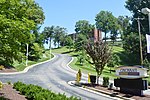Lower Price Hill Historic District
AC with 0 elementsAppalachian culture in CincinnatiGuatemalan-American cultureHamilton County, Ohio Registered Historic Place stubsHistoric districts in Cincinnati ... and 3 more
Historic districts on the National Register of Historic Places in OhioNRHP infobox with nocatNational Register of Historic Places in Hamilton County, Ohio

Lower Price Hill Historic District is a registered historic district in Price Hill, Cincinnati, Ohio, listed in the National Register on November 15, 1988. It is roughly bounded by West Eighth Street, State Street, Burns Street, and English Street. It is located just across the railroad tracks to the west of downtown Cincinnati. This region contains 196 contributing buildings, including single and multiple dwellings, as well as a few businesses. Lower Price Hill is served by the Lower Price Hill Community School.
Excerpt from the Wikipedia article Lower Price Hill Historic District (License: CC BY-SA 3.0, Authors, Images).Lower Price Hill Historic District
Staebler Street, Cincinnati Lower Price Hill
Geographical coordinates (GPS) Address Nearby Places Show on map
Geographical coordinates (GPS)
| Latitude | Longitude |
|---|---|
| N 39.103611111111 ° | E -84.552222222222 ° |
Address
Staebler Street 2139
45204 Cincinnati, Lower Price Hill
Ohio, United States
Open on Google Maps








